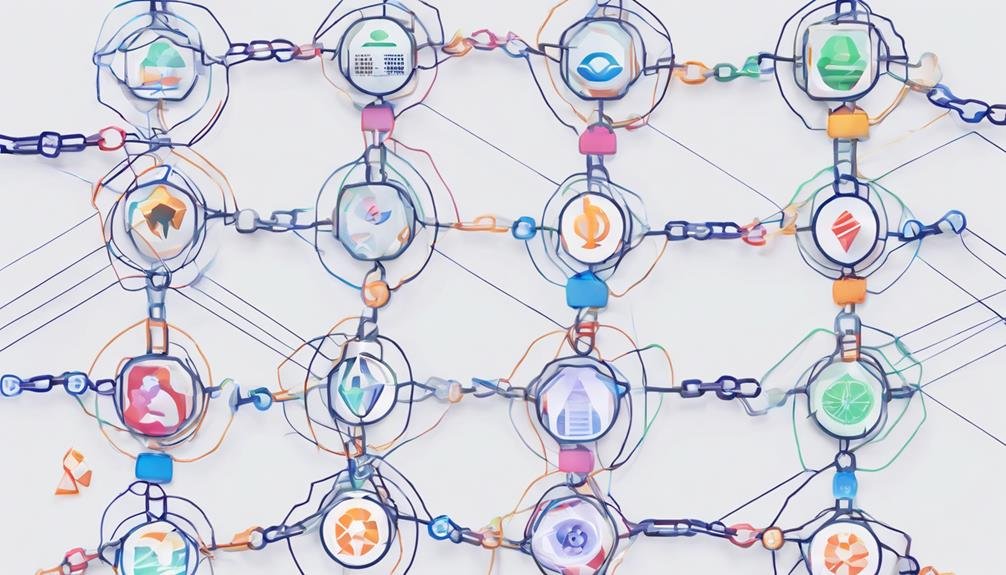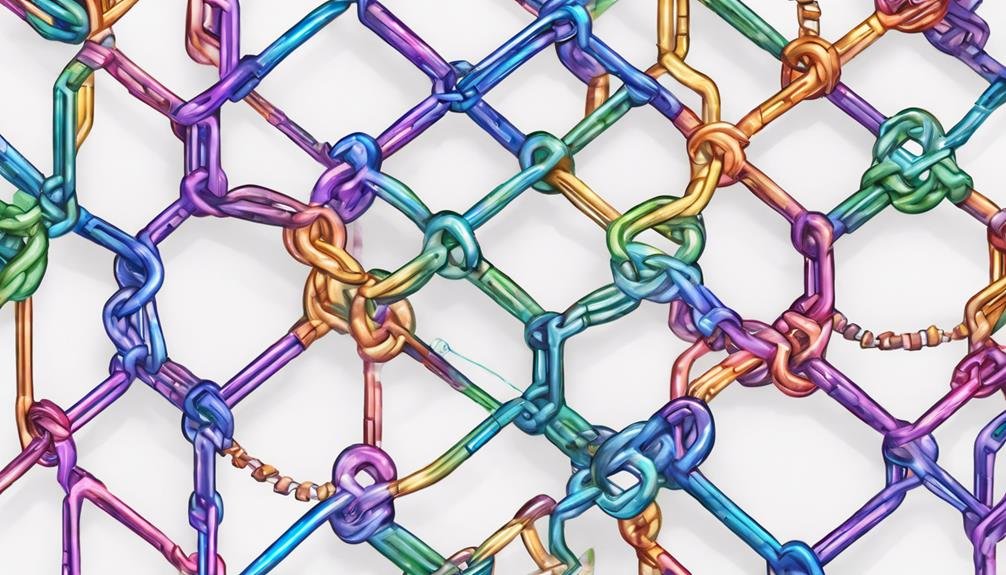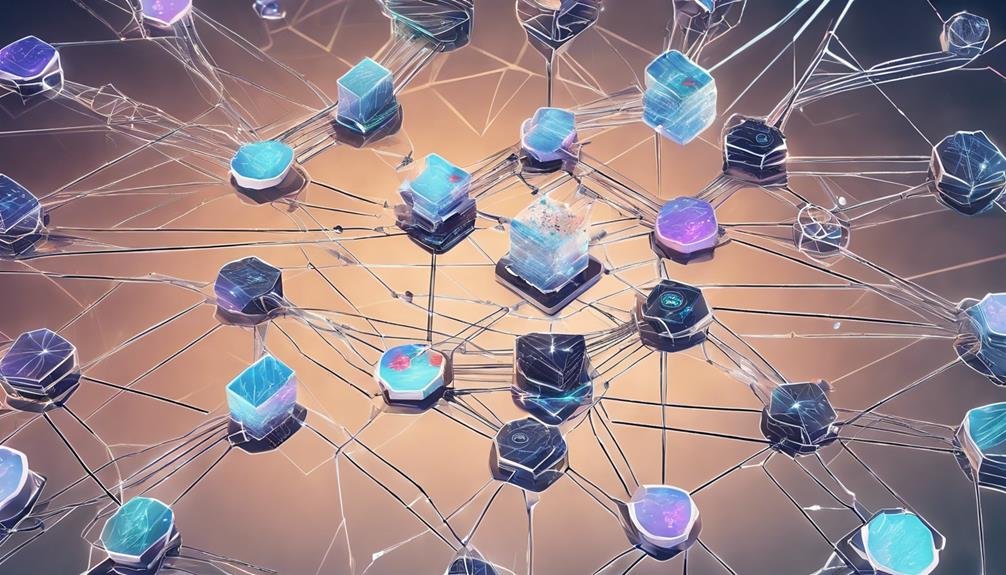Multichain tokens enhance DeFi by boosting interoperability, scalability, security, and transaction efficiency. They connect various blockchain networks, enabling seamless asset transfers and diversifying transaction options. Multichain tokens distribute transactions, reducing network congestion and speeding up processing. They adhere to specific standards, promoting cross-chain liquidity and scalability. Embracing these tokens enhances DeFi security through decentralized asset management and advanced security measures. Users gain flexibility, control, and enhanced liquidity opportunities in the DeFi space by tapping into different blockchain networks. The intricate web of benefits multichain tokens offer in DeFi hints at their vast potential.
Table of Contents
Brief Overview of How Do Multi Chain Tokens Work?
- Distributed assets reduce single-point failures, enhancing security and stability in DeFi.
- Multichain tokens promote interoperability, improving liquidity and accessibility on DeFi platforms.
- Users gain flexibility by interacting with diverse blockchain networks, empowering control over assets.
- Interoperable tokens act as bridges between blockchains, expanding asset transfers and reducing risks.
- Scalability advantages include faster transactions, increased capacity, and improved efficiency in DeFi.
Interoperability Benefits of Multi-Chain Tokens
Enhancing decentralized finance (DeFi) with multichain tokens brings significant interoperability benefits to the blockchain ecosystem. These tokens bridge different blockchain networks, facilitating seamless asset transfers and expanding the scope of available assets and services in DeFi. Multichain tokens enhance liquidity by enabling interoperability, allowing users to access a more extensive range of financial products and services across various chains. This reduction in reliance on a single network mitigates the risks of congestion and network failures and promotes efficiency in executing complex financial transactions.
Moreover, the innovative nature of multichain tokens empowers DeFi platforms to offer diverse and creative financial products to a global user base. The ability to interact with multiple blockchains efficiently opens up new possibilities for developing decentralized applications and services, fostering growth and advancement within the decentralized finance space. Through interoperability, multichain tokens contribute to the evolution of DeFi by creating a more interconnected and flexible financial ecosystem.
Scalability Advantages in DeFi

In DeFi, the advantages of scalability are essential for optimizing transaction speeds and system efficiency. Multichain tokens play a vital role in enhancing scalability within DeFi networks. Here are some key benefits of scalability advantages in decentralized finance:
- Multichain tokens help distribute transactions across various blockchain networks, reducing congestion in DeFi networks.
- Improved transaction processing speeds are achieved by utilizing multichain solutions in DeFi.
- Scalability advantages lead to increased transaction capacity, allowing for more efficient and seamless transactions within the decentralized finance ecosystem.
- By leveraging the capabilities of different blockchain networks, multichain tokens enhance system efficiency in DeFi, providing a
Token Standards for Multi-Chain Functionality

Token standards for multichain functionality are essential in enabling seamless asset movement and interoperability across different blockchains. These standards, like the Pantos Digital Asset Standard (PANDAS), facilitate direct transfers of tokens between chains without requiring users to give up custody. By leveraging technologies such as threshold signature schemes and distributed vital generation protocols, multichain tokens guarantee secure cross-chain transactions, enhancing connectivity and liquidity in the DeFi space.
Interoperability for Cross-Chain
Revolutionizing decentralized finance ecosystems, interoperable token standards like Pantos Digital Asset Standard (PANDAS) facilitate seamless asset movement between blockchains. This cross-chain functionality allows tokens to interact with various blockchain networks, promoting liquidity and connectivity within DeFi ecosystems. Multichain token standards enhance scalability and cross-chain liquidity in DeFi platforms.
Direct asset transfers and seamless connectivity between different blockchain networks become achievable with interoperability across chains. Transferring assets directly between chains boosts efficiency and accessibility in decentralized finance, providing users with more flexibility and opportunities for diverse investments.
Seamless Transfers Between Chains
Enhancing decentralized finance ecosystems, seamless transfers between different blockchains are facilitated by token standards like Pantos Digital Asset Standard (PANDAS). Multichain tokens enable direct asset transfers, boosting liquidity in DeFi without guaranteeing custody. Interoperable standards streamline asset movements across diverse blockchain networks. Pantos technology guarantees efficient token interaction with various blockchains, enhancing DeFi functionality.
Multichain token systems revolutionize the DeFi industry by improving cross-chain connectivity and accessibility. By adhering to these token standards, users can seamlessly transfer assets between different blockchain networks, fostering a more interconnected and efficient DeFi ecosystem. Utilizing multichain tokens paves the way for enhanced liquidity, increased accessibility, and improved functionality within the DeFi space.
Enhancing Defi Security With Multi-Chain Tokens

How can DeFi platforms fortify their security measures effectively by incorporating multichain tokens? Multichain tokens play a vital role in enhancing DeFi security through various mechanisms:
- Diversification: By utilizing multiple blockchains, DeFi platforms reduce the risk of single points of failure, enhancing overall security.
- Enhanced Protocols: Leveraging different chains allows for implementing advanced security protocols and safeguarding smart contracts and transactions.
- Decentralized Consensus: Multichain tokens enable decentralized asset management, ensuring consensus mechanisms are distributed across various networks.
- Interoperability: Improving interoperability between blockchains enhances security by diversifying assets and transactions within the DeFi ecosystem.
Transaction Efficiency Across Blockchain Networks

Multichain tokens streamline transactions across different blockchain networks, optimizing the movement of assets and enhancing operational efficiency. These tokens facilitate faster transactions and reduce congestion on individual networks by enabling seamless cross-chain interoperability. Enhanced liquidity opportunities arise as DeFi protocols can tap into a wider pool of assets, fostering a more vibrant and dynamic ecosystem.
Cross-Chain Interoperability Benefits
By establishing seamless connections between different blockchain networks, cross-chain interoperability significantly boosts transaction efficiency in decentralized finance.
- Multichain tokens enable swift asset transfers across various blockchains.
- Interoperable tokens enhance access to liquidity and diverse financial services in DeFi.
- Global transactions and cross-border payments become faster and more secure with multichain tokens.
- Leveraging multiple chains in decentralized finance enhances network resilience, reducing dependency on single blockchain limitations.
Enhanced Liquidity Opportunities
Enhancing DeFi with Multichain Tokens enables enhanced liquidity opportunities, facilitating seamless asset transfers across different blockchain networks and enhancing transaction efficiency. Multichain solutions improve scalability and interoperability, allowing a more interconnected ecosystem within decentralized finance (DeFi). These tokens enhance liquidity provision by bridging various blockchain networks and creating new trading opportunities.
The transaction efficiency achieved through multichain tokens reduces bottlenecks and enhances the speed of asset transfers, ultimately boosting liquidity in DeFi protocols. Users benefit from accessing a more comprehensive range of assets and markets, increasing liquidity opportunities. Integrating multichain tokens fosters a more efficient and interconnected DeFi ecosystem, supporting enhanced liquidity and trading capabilities.
Diversification and Risk Mitigation Through Multi-Chain Tokens

Diversification and risk mitigation are pivotal aspects of DeFi that can be effectively enhanced by utilizing multichain tokens. By spreading assets across different blockchain networks, users and developers can benefit in various ways:
- Access to Different Networks: Multichain tokens enable users to interact with various blockchain networks, expanding their opportunities within the DeFi space.
- Reduced Vulnerability: Distributing assets across multiple chains decreases the risk of single-point failures, enhancing security and stability.
- Enhanced Interoperability: Multichain tokens promote interoperability, improving liquidity and accessibility on DeFi platforms.
- Optimized User Experience: Users can select blockchain networks based on fees and transaction speeds, tailoring their DeFi experience to suit their preferences.
Embracing multichain tokens offers flexibility in network selection and empowers users with greater control over their assets, ultimately enriching the DeFi ecosystem.
Frequently Asked Questions
How Do Multichain Tokens Work?
Multichain tokens enhance DeFi through interoperability benefits, cross-chain transfers, dual-chain rewards, liquidity pools, decentralized exchanges, yield farming, smart contracts, token bridges, layer 2 solutions, and security advantages. They enable seamless movement and diversified exposure.
What Is the Use of Multichain Classification?
Understanding multichain classification benefits you in maneuvering the interoperability and connectivity of tokens. It aids in identifying suitable tokens for various blockchain applications, offering enhanced utility, diversified ecosystems, and improved scalability across different chains.
How Do Tokens Exist on Multiple Blockchains?
Tokens exist on multiple blockchains through cross-chain interoperability, using blockchain bridges for token migration. Consensus mechanisms guarantee security, while decentralized exchanges facilitate inter-blockchain communication. Smart contracts govern liquidity pools and staking rewards, enhancing DeFi accessibility and connectivity.
What Are the Benefits of Blockchain Tokens?
Blockchain tokens offer various benefits, including interoperability advantages, liquidity pools, cross-chain swaps, enhanced security, diversified ecosystems, scalability solutions, decentralized governance, improved tokenomics, enhanced user experience, and global adoption opportunities. These features drive innovation and growth in decentralized ecosystems.
Conclusion
To sum up, utilizing multichain tokens in DeFi offers a variety of advantages, including enhanced interoperability, scalability, security, transaction efficiency, and risk mitigation. DeFi platforms can improve functionality by utilizing multiple blockchain networks and providing users with a more robust and diversified ecosystem. Like a key that opens up numerous doors, multichain tokens expand new possibilities and opportunities for the decentralized finance space, paving the way for a more interconnected and resilient financial system.




